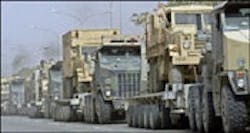TARDEC Purifies Water From Vehicle Exhaust
The U.S. Army's Tank Automotive Research, Development and Engineering Center (TARDEC) announced that it has developed a vehicle-based water purification, generation and recovery technology to deliver a dependable source of potable water from emissions. Developed in concert with Lexington Carbon Company, the Water Recovery Unit from Exhaust (WRUE) technology condenses water from exhausted gas, and then purifies it using a three-stage filtration process. Once enough water is collected in an on-board storage tank, Soldiers can draw water from a tap located on the vehicle.
"Our troops in the field require up to three gallons of water every day to prevent dehydration," said Dr. Richard McClelland, director of TARDEC. "This breakthrough technology not only reduces the logistic footprint of water transportation, but it also makes a seemingly useless vehicle waste a valuable commodity."
TARDEC leads the Army's water distribution and purification research efforts. In addition, TARDEC is currently working with the Office of Naval Research to develop an Expeditionary Unit Water Purifier (EUWP) as part of a congressionally sponsored program designed to reduce the overall cost of purifying water. Based on an ultra-filtration membrane process followed by a reverse osmosis desalination process, the system is capable of purifying, storing and dispensing potable water in any austere environment from virtually any potential source of water. The EUWP is compatible with a number of commercial and military line haul transporters, and can be brought in by air using a single sortie of C-130 fixed-wing aircraft.
The 100,000 gallon per day EUWP was designed and fabricated within 15 months of contract award and is currently undergoing a functional evaluation at the Naval Facilities Engineering Service Center's Seawater Desalination Test Facility in Pt. Hueneme, Calif. The final destination for this system is the Bureau of Reclamation's Tularosa Basin National Desalination Research Facility in Alamagordo, N.M., where it will be used to evaluate emerging water purification technologies.
The success of the EUWP concept has generated the authorization to fabricate a second system that will be used to evaluate alternative operational concepts to include both military (humanitarian aid, nation building, Sustainment and Support Operations) and civil support (disaster relief, emergency response, homeland security) missions. Currently, TARDEC plans to demonstrate the second unit at Camp Lemonier, Djibouti, Africa, in support of the Coalition Joint Task Force Horn of Africa.
"TARDEC is proud to provide technical support to ONR in developing this EUWP as we assist our Joint Expeditionary efforts supporting the Global War on Terrorism effort," McClelland added.
The WRUE technology is based on the primary combustion products of diesel fuel -- water and carbon dioxide. Theoretically, one gallon of diesel fuel produces approximately one gallon of water. In order to recover potable water from engine emissions, the water must be condensed from the exhaust gas and then purified. The condensate contains oxides of nitrogen and sulfur and a number of other regulated contaminants removed during the three-stage filtration process. Test results demonstrated a system that consistently recovered 50 to 60 percent of the theoretically available water, all of which is suitable for drinking.
Once the water is collected and purified, troops can draw water out of an on-board storage tank from a tap located near the rear passenger side of the vehicle.
TARDEC's WRUE technology addresses a considerable Future Force need to supply troops by generating enough water required to sustain a brigade-size element. An analysis performed by the Quartermaster Center and School predicted that water will account for 30 to 40 percent of the Future Force daily sustainment weight requirement. It is predicted that the Future Force will require 100 tons (25,000 gallons) of water per day. In generating clean water from vehicle exhaust, the WRUE can greatly reduce the logistic footprint of the Future Force.
TARDEC, headquartered at the Detroit Arsenal, Warren, Mich., is the nation's laboratory for advanced military automotive technology. TARDEC's mission is to research, develop, engineer, leverage and integrate advanced technology into ground systems and support equipment throughout the life cycle. TARDEC's 1,100 associates develop and maintain vehicles for all U.S. Armed Forces, many federal agencies and more than 60 foreign countries. TARDEC pushes the state-of-the-art in programs including power and energy, advanced collaborative environments, robotics, electric drive and embedded simulation to provide the Army with the materiel solutions it demands. TARDEC leads several Army Future Force science and technology efforts -- collaborating with the Army's combat developers -- to ensure we field robust equipment that meets aggressive cost, schedule and performance standards.
Source: TARDEC
